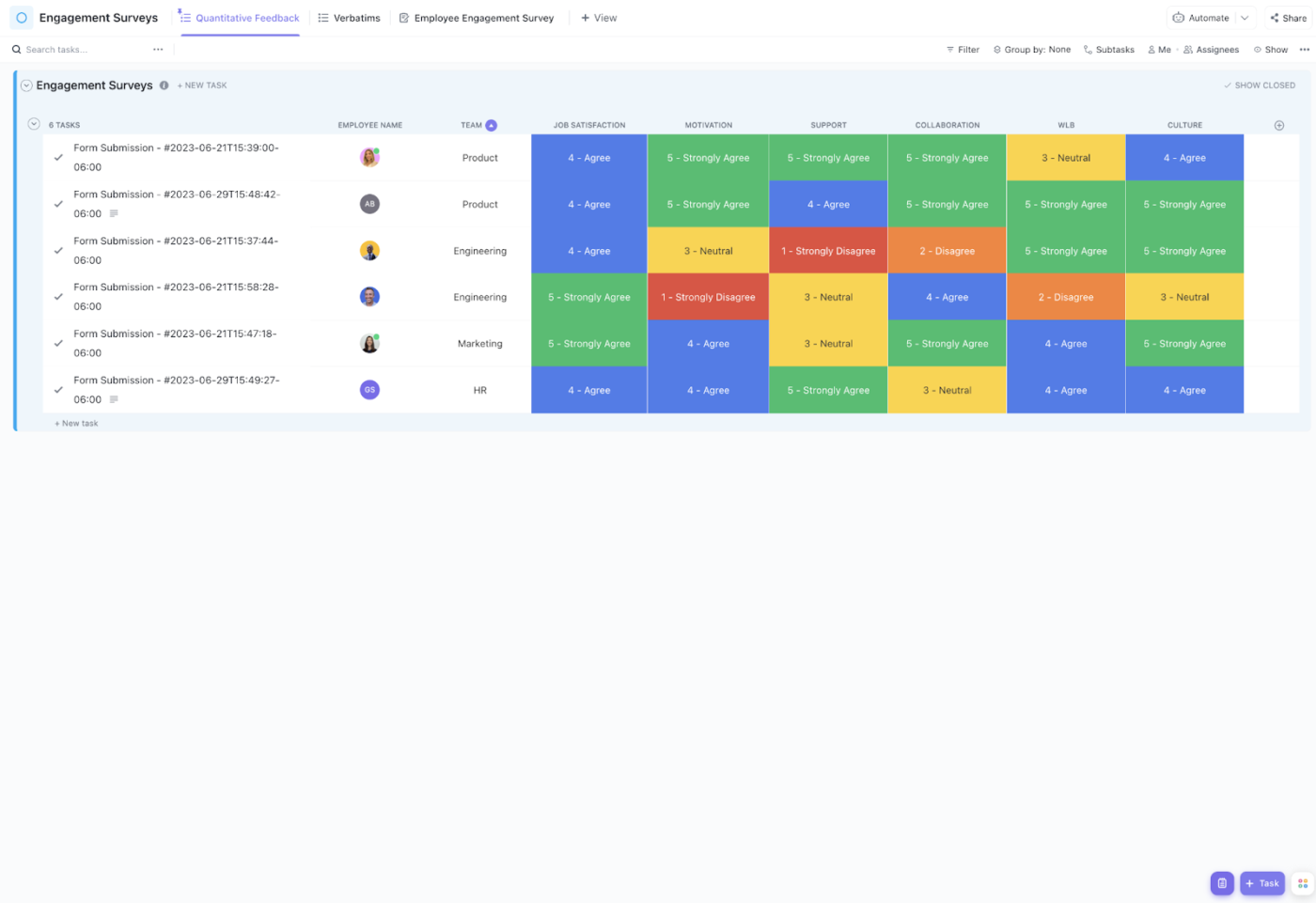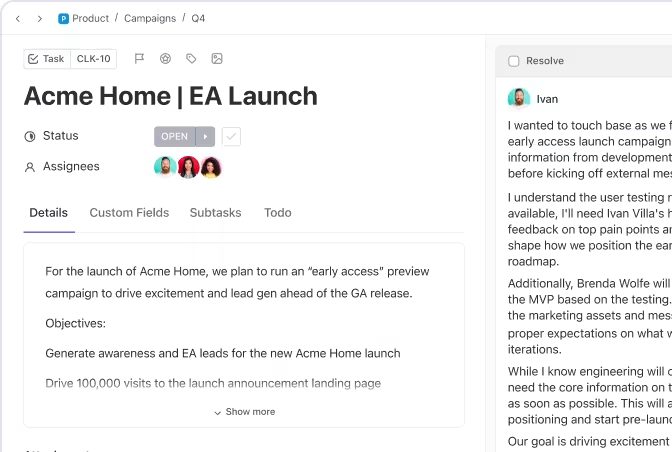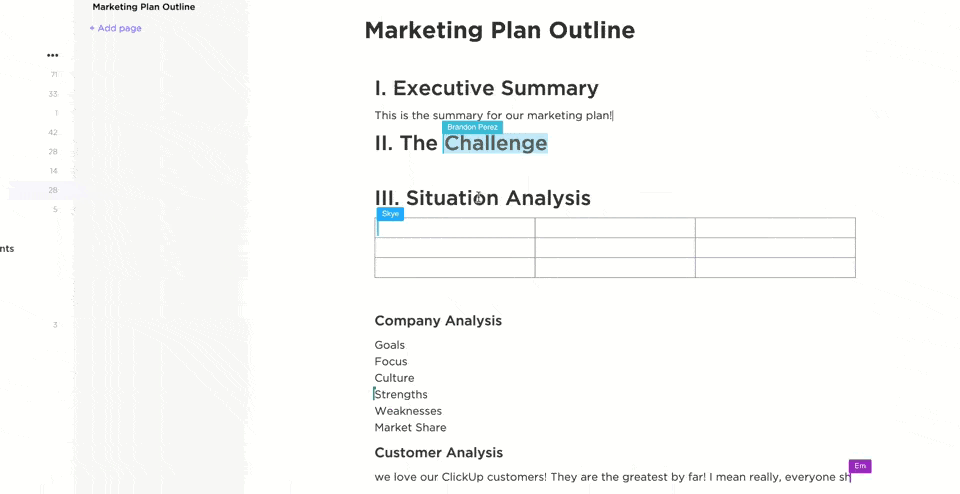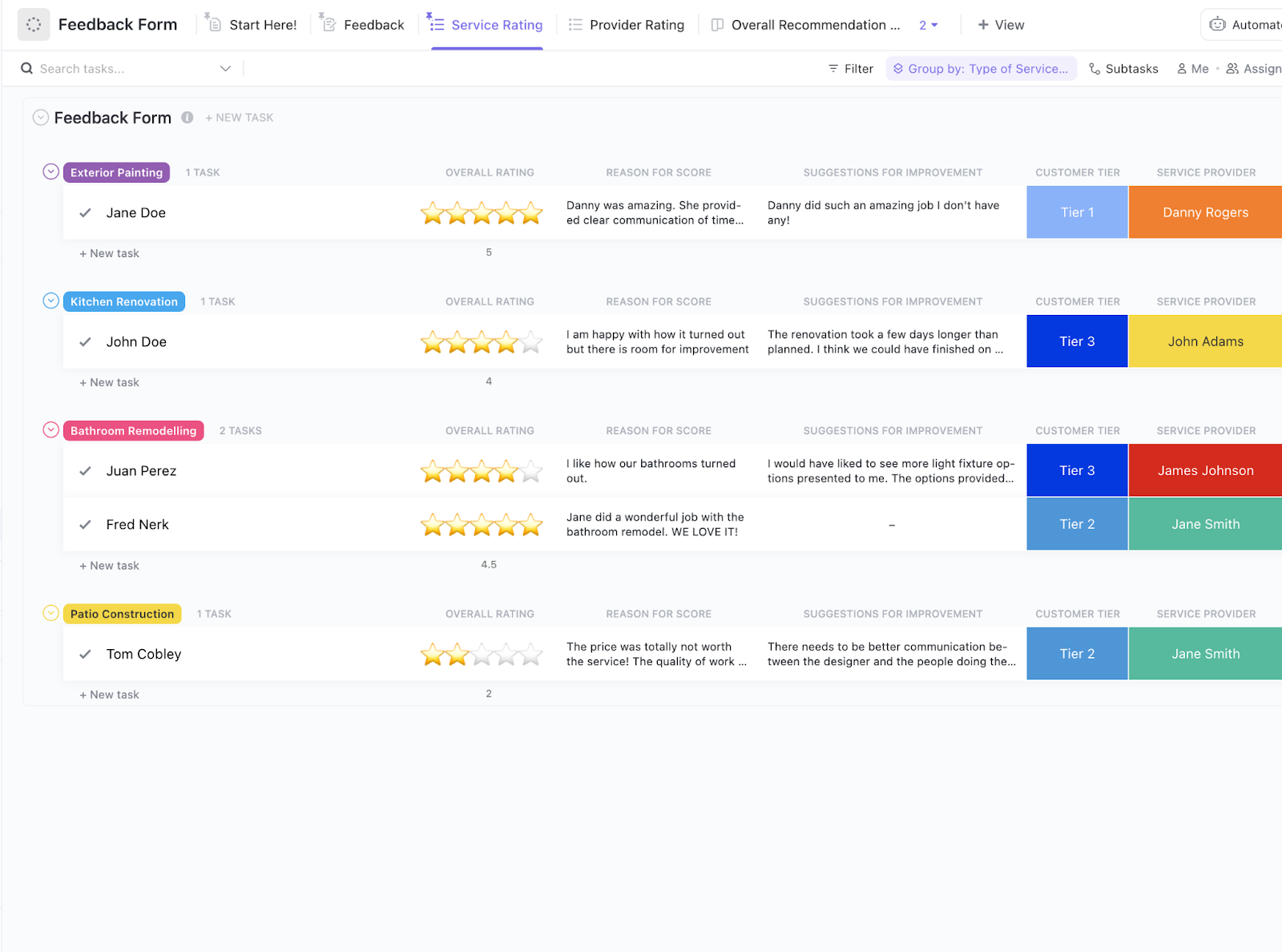96% of employees say regular feedback is valuable—so why do traditional performance reviews still feel so one-sided?
Traditional performance reviews often put all the power in the hands of a single manager, overlooking the perspectives of peers, reports, and cross-functional collaborators who see different sides of an employee’s impact.
The 360-degree feedback process is a smarter alternative. It gathers insights from peers, direct reports, and even internal or external customers, transforming feedback from a monologue to a conversation. It also helps employees gain a clearer understanding of their strengths and areas for improvement.
But here’s the catch: a poorly structured feedback process can lead to frustration and resentment. Without an action plan, valuable insights go to waste.
So, how do you effectively implement 360-degree feedback to drive employee growth and accountability? Let’s break it down.
What Is the 360-Degree Feedback System
The 360-degree feedback system is a performance review system that collects input from a full circle of colleagues—peers, direct subordinates, managers—and sometimes even customers.
While direct managers provide valuable insights as part of traditional performance reviews, they can’t evaluate everything—how employees collaborate with peers, lead a team, or interact with clients.
That’s why 360-degree feedback results in a well-rounded view of an employee’s strengths, blind spots, and growth areas.
How the 360-degree feedback system works
360-degree feedback provides a complete picture of an employee’s performance by gathering input from multiple perspectives. Employees start with a self-evaluation, reflecting on their strengths, weaknesses, and contributions.
Meanwhile, feedback is collected anonymously from various sources, including managers, peers, direct reports (if applicable), and sometimes even clients in customer-facing roles. This multi-source approach highlights areas for growth, reinforces strengths, and reduces bias.
The evaluation typically focuses on:
- Leadership and decision-making: Confidence and effectiveness in guiding others
- Communication and teamwork: The ability to collaborate and maintain strong relationships
- Problem-solving and innovation: Contribution to creative solutions and critical thinking
- Accountability and reliability: Consistency in meeting expectations and following through
- Emotional intelligence: Response to feedback, stress management, and interpersonal skills
Combining these perspectives helps employees gain deeper self-awareness, refine their skills, and align personal development with organizational goals.
360-degree feedback vs. traditional performance appraisals
While traditional appraisals focus on past performance, 360-degree feedback is future-focused, helping employees develop new skills and overcome career obstacles. Here’s a clear breakdown of the two styles to help you choose better:
| Aspect | 360-degree feedback | Traditional performance appraisal |
| Who provides feedback? | Managers, peers, subordinates, clients (if relevant) | Direct manager only |
| Focus | Competencies, behavior, leadership, teamwork | Task performance, job responsibilities |
| Bias risk | Lower—multiple perspectives balance biases | Higher—depends on one manager’s viewpoint |
| Anonymity | Yes, for peer and direct report feedback | No, feedback is direct and formal |
| Outcome | Professional development, growth areas, leadership insights | Promotions, salary decisions, performance ranking |
Benefits of 360-Degree Feedback
Here’s why implementing a 360-degree feedback system is worth considering:
Provides a balanced view of performance
👉🏼 Imagine Sarah, a team lead in product marketing. Her manager praises her strategic thinking and timely execution. But her peers in design mention that she sometimes rushes briefs, leading to misalignment. Meanwhile, her reports highlight how supportive and empowering she is as a leader.
With traditional reviews, only the manager’s view might be captured—making Sarah seem flawless. However, with 360-degree feedback, both her strengths and areas for growth emerge.
Reduces bias in evaluations
Input from multiple sources minimizes favoritism and unconscious bias, making assessments more objective and fair.
Encourages self-awareness and growth
Comparing self-assessments with others’ feedback helps employees identify blind spots and recognize strengths.
👉🏼 In Sarah’s case, she can see the impact of her pace on cross-functional collaboration and can address it, while also recognizing the positive influence she has on her team.
Strengthens teamwork and collaboration
Constructive feedback fosters trust, improves communication, and helps employees see how their actions impact the team.
Enhances leadership and career development
The forward-looking approach used in 360-degree feedback helps identify leadership potential, highlights coaching needs, and supports succession planning for future leaders.
👀 Did You Know? Employees who receive daily feedback from their manager are 3.6 times more likely to feel highly motivated to deliver outstanding work than those who receive feedback annually.
Aligns employee growth with company goals
Personalized development plans ensure employees improve in ways that benefit both them and the organization.
👉🏼 Based on her peers’ feedback, Sarah might work on improving cross-functional collaboration by attending a workshop on creative briefing or setting up regular syncs with design. To amplify her leadership strengths, she could mentor a junior marketer or lead a cross-team initiative, deepening her impact while reinforcing what she’s already doing well.
Boosts engagement and retention
👀 Did You Know? According to Gallup, 80% of employees receiving meaningful feedback are highly engaged the following week.
Fair, actionable feedback makes employees feel valued, increasing motivation and job satisfaction.
📖 Also Read: How to Amplify Employee Voice in the Workplace
Challenges and Drawbacks of 360-Degree Feedback
While 360-degree feedback can be a powerful development tool, poor execution can lead to confusion and resistance. Here are the key challenges and how to address them:
1. Time-consuming and resource-intensive
Collecting, analyzing, and delivering feedback takes effort; rushed surveys can lead to shallow responses. A 360 feedback software tool can streamline the process, and keeping surveys concise prevents burnout.
📌 For example, cutting a 50-question survey down to 15 could lead to more thoughtful feedback.
2. Potential for unconstructive or biased feedback
Without structure, feedback can become vague, overly negative, or driven by personal conflicts. Proper training on giving objective, actionable feedback and using rating scales can improve results. Encouraging employees to ask for feedback and receive multi-rater feedback in specific areas also leads to more valuable insights.
📌 For example, instead of saying, “Sam is a bad leader,” structured feedback might say, “Sam provides clear instructions (4/5) but could improve in giving regular feedback (2/5).”
3. Employees may feel overwhelmed or defensive
Receiving a flood of criticism at once can feel like an attack, making employees resistant to growth. Framing feedback as a development tool and offering coaching sessions helps employees process it productively.
📌 A manager, for instance, might break feedback into key themes and create an action plan rather than overwhelming employees with all the details in one meeting.
4. Lack of trust and anonymity concerns
If employees fear retaliation, they may not give honest feedback. Ensuring responses are genuinely anonymous and reassuring employees that honest input is protected fosters trust.
📌 An HR team, for example, might use structured, anonymous surveys for peer reviews and communicate that feedback won’t be linked to individuals.
3. Feedback without action is meaningless
Employees won’t take the process seriously if feedback isn’t acted on. Turning feedback sessions into personalized development plans and holding follow-up sessions ensures progress.
📌 A company that sees repeated concerns about communication gaps could introduce leadership training focused on active listening, clear delegation, and feedback delivery, and see noticeable improvements.
6. Not suitable for every organization
Small teams may struggle with anonymous employee feedback since it is easier to guess who said what. In such cases, peer coaching or external facilitators can help maintain objectivity.
📌 A 10-person team, for instance, could transition from anonymous surveys to structured discussions, building a culture of trust. This would directly enhance organizational performance development.
📖 Also Read: Free Start Stop Continue Templates
Implementing 360-Degree Feedback in Your Organization
Implementing a 360-degree feedback system is more than simply collecting opinions—it’s creating a structured, fair, and action-driven process. Curious how to go about it the right way? Follow our step-by-step guide to set it up.
Step-by-step guide to setting up a 360-degree feedback system
Step 1: Define your objectives
Determine if the feedback is for employee development, leadership assessment, or performance evaluation. Clearly communicate whether it impacts promotions or serves purely as a growth tool.
👉🏼 Example: A company might use 360-degree feedback to strengthen leadership skills for functional heads rather than as a tool for formal performance reviews.
Step 2: Choose the right participants
Feedback should come from multiple sources: self-assessment, direct managers, peers, direct reports, and, optionally, external stakeholders.
Each perspective reveals a different dimension of performance.
- Self-assessment shows self-awareness and personal reflection
- Managers evaluate strategic impact and goal alignment
- Peers see day-to-day collaboration and teamwork
- Direct reports offer insight into leadership and communication style
- External stakeholders (like clients or partners) reflect professionalism and relationship management
Together, these inputs create a fuller, more accurate picture, helping individuals grow in ways a single viewpoint simply can’t capture.
📖 Also Read: Manager Feedback Examples: A Guide for Leaders
Step 3: Select the feedback format and tools
For balanced insights, use surveys (numerical ratings), open-ended questions, or a hybrid approach. This gives you both quantifiable data and context-rich feedback.
While numerical ratings make it easy to spot trends, benchmark performance, and track progress over time, open-ended questions can reveal the “why” behind the ratings. A hybrid approach balances objectivity with depth, turning raw data into meaningful, actionable insights.
Step 4: Ensure anonymity and confidentiality
Employees give honest feedback only when they feel safe. To create psychological safety around the feedback process, use third-party employee feedback tools, avoid small feedback groups, and emphasize that feedback is for growth, not punishment.
👉🏼 Example: Your HR team may collect anonymous team-wide employee evaluations rather than one-on-one ratings to maintain employee privacy.
Step 5: Design straightforward, unbiased questions
Ask specific, actionable questions to gather valuable insights and foster constructive criticism rather than vague or leading prompts.
👉🏼 Example: Instead of vague questions like “Is Marianna a good leader?” ask, “How well does Marianna handle team conflicts on a scale of 1–5?”
Step 6: Communicate the process to employees
Address skepticism by explaining why 360-degree feedback is being implemented, how it will be used, and how confidentiality is ensured. You can also hold sessions to teach employees how to give constructive, balanced feedback and how to receive it with an open mind. This sets a positive tone and reduces anxiety.
💡 Pro Tip: Have leaders go through the process first and share their experience openly. It signals psychological safety and encourages honest participation.
Step 7: Launch and collect feedback
Distribute surveys, set deadlines, send reminders, and provide HR support for employees with 360 evaluation questions.
Here are some ways to do this:
- Set up a help desk or contact point: Designate a person or shared inbox (e.g., hr-support@company.com) to handle questions, clarify confusion, or troubleshoot survey issues
- Offer office hours or drop-in sessions: Create time blocks where employees can ask questions live, either in person or via video call, to get real-time guidance
- Provide clear documentation: Share FAQs, step-by-step guides, and example responses to help employees understand what’s expected and how to give constructive feedback
- Reinforce confidentiality and purpose: Reassure participants that their input is anonymous and developmental, not punitive. HR should be ready to repeat this message consistently
- Support managers, too: Train managers on how to interpret feedback reports and facilitate post-review conversations in a productive, supportive way
Step 8: Analyze and interpret results
Identify recurring themes, strengths, and areas for improvement while comparing self-perception to external feedback.
An employee may believe they communicate well, but peer feedback could highlight a need for better listening.
Step 9: Deliver feedback
Present feedback in one-on-one meetings, starting with strengths before addressing improvement areas. This approach helps you create a safe, personalized space for open dialogue. It also builds the employee’s trust and confidence, making them more receptive to growth areas that follow.
👉🏼 Example: Instead of “You’re not a good listener,” a manager says, “Teammates would appreciate more opportunities to share their ideas with you.”
Step 10: Take action and follow up
Turn feedback into personal development goals, provide resources, and track trends for long-term improvement. Some employees may benefit from tailored courses and coaching programs, while others may need stretch assignments to support their growth. Implement strategies accordingly and track progress over time to adjust development plans.
👉🏼 Example: If team dynamics are problematic, the company introduces workshops on teamwork and collaboration, spaces for people to get to know each other outside of work, and shared activities to strengthen coordination..
Best practices for maximizing the effectiveness of feedback surveys
Collecting feedback is only half the battle—what truly matters is how you design, deliver, and act on it. Here are the best practices for making feedback surveys effective, meaningful, and actionable:
- Use feedback for growth, not evaluation: If employees believe feedback impacts promotions or salaries, they’ll sugarcoat responses. Make it clear that feedback is for development, not performance reviews
- Choose raters who actually know the person: Feedback is only useful when it comes from colleagues who have worked closely with the individual. Avoid input from those with little interaction
- Ditch the corporate jargon—ask real questions: Replace vague prompts like “Does this person demonstrate leadership?” with specific ones like “Would you trust this person to lead a project you care about?”
- Balance anonymity with useful context: People must feel safe providing honest feedback, but vague responses aren’t helpful. Encourage specific examples, e.g., “Sometimes delays project updates, leading to confusion.”
- Pair feedback with coaching: A list of weaknesses without guidance can be demoralizing. Assign a coach, mentor, or manager to help employees turn insights into action
- Make feedback a regular habit: Annual surveys quickly fade from memory. Introduce lightweight, quarterly feedback loops so employees can adjust and improve continuously
- Follow up with action plans: Feedback is pointless if nothing changes. Set specific goals, e.g., instead of “Improve teamwork,” aim for “Seek input from at least two colleagues before finalizing decisions.”
- Never weaponize feedback: If employees feel their responses are used against them in performance calibration meetings or evaluations, they’ll stop being honest. Keep feedback private and focused on growth
- Leaders must set an example: Employees won’t take feedback seriously if leadership isn’t actively participating. When managers embrace feedback, it fosters a culture of continuous improvement
👀 Did You Know? 61% of employees consider leaving their jobs, citing poor internal communication as a factor, with 26% naming it a significant cause.
Utilizing ClickUp for organizing and managing feedback tasks and workflows
Work today is broken. 60% of our time is spent sharing, searching for, and updating information across different tools. Our projects, documentation, and communication are scattered across disconnected tools that drain productivity.
ClickUp fixes this with the everything app for work, which combines projects, knowledge, and chat in one place—all powered by AI that helps you work faster and smarter.
📮ClickUp Insight: Low-performing teams are 4 times more likely to juggle 15+ tools, while high-performing teams maintain efficiency by limiting their toolkit to 9 or fewer platforms. But how about using one platform?
As the everything app for work, ClickUp brings your tasks, projects, docs, wikis, chat, and calls under a single platform, complete with AI-powered workflows. Ready to work smarter? ClickUp works for every team, makes work visible, and allows you to focus on what matters while AI handles the rest.
From collecting responses to tracking progress, here’s how ClickUp for HR teams helps manage feedback better—turning it into structured workflows that drive real growth.
Simplify feedback collection with the ClickUp Form View
The biggest challenge with feedback is getting structured, actionable responses. The ClickUp Form View eliminates the chaos by standardizing how teams collect and organize feedback.

You can easily design questions using multiple formats, such as numerical ratings, multiple choice, or open-ended responses. The Form View helps collect this data in a structured format, automatically organizing it into ClickUp Tasks or Lists for easy tracking, analysis, and reporting.
Use filters and sort options to organize and analyze the responses by individual, team, or feedback category.
With this setup, you can easily manage multiple reviews, keep feedback anonymous, and provide HR with a clear overview of performance data and development needs.
Here’s a quick explainer on how ClickUp Forms turn responses into results 🎥
💡 Pro Tip: Want to spot trends across multiple feedback submissions? Analyze form responses with ClickUp’s native AI assistant, ClickUp Brain!

But that’s not all; human resources teams can use the ClickUp Feedback Form Template to create a consistent, repeatable system.
With this template, HR teams can:
- Customize form fields to gather targeted feedback on leadership, teamwork, and performance
- Automate task assignments and follow-ups based on responses, and keep tabs on progress
- Categorize feedback based on roles, skills, or development areas, ensuring insights reach the right managers
Since the feedback form automatically integrates with ClickUp’s task management system, feedback instantly becomes an actionable item.
Turn feedback into growth with goal-tracking

Feedback is meaningless if it doesn’t lead to change. The ClickUp Goals feature helps subordinates and managers turn insights into structured development plans. Instead of vague improvement suggestions, employees can create measurable, trackable goals that align with their feedback.
📌 Example:
Sarah receives 360-degree feedback, noting that her team wants more clarity during project kickoffs. Instead of a vague goal like “Improve project clarity”, she creates a SMART goal in ClickUp:
“Improve project kickoff clarity by hosting structured kickoff meetings for all Q2 campaigns by June 30.”
She then uses ClickUp to:
- Break it down into subtasks like:
- Create a kickoff meeting agenda template
- Schedule meetings 1 week before each campaign
- Ask for peer feedback after each kickoff
- Set due dates and assign tasks to herself or collaborators
- Use ClickUp’s progress tracking to monitor completion (% of subtasks done)
- Automate reminders so she stays on track without micromanagement
This way, feedback becomes a measurable, visible, and achievable goal—tracked in real time
Implement feedback with effective task management

Once feedback is received, the real challenge is execution. ClickUp’s Task Management tools bridge the gap between insights and action by providing a structured way to implement changes. Employees can:
- Convert feedback into tasks and break them into subtasks
- Assign action items to themselves or managers for structured follow-ups
- Set due dates and track progress over time
- Use recurring tasks for ongoing skill-building and check-ins
For example, if employees receive feedback about improving cross-team communication, they can create a weekly task to initiate check-ins with different departments.
Ensure real-time improvements with seamless collaboration

Feedback should spark conversations, not just sit in reports. ClickUp’s Instant and Live Collaboration keeps discussions focused and productive by centralizing all communication in one place. Instead of juggling Slack messages, emails, and meeting notes, teams can:
- Use ClickUp Docs to store feedback summaries and personal development plans
- Add comments directly to tasks to discuss specific feedback points
- Tag team members for instant updates and real-time collaboration
- Set up automated reminders to ensure follow-through on feedback-driven tasks
Gain actionable insights with custom dashboards

Understanding feedback trends across teams and departments is just as important as fostering individual growth. ClickUp Dashboards give HR teams a high-level view of feedback data, allowing them to track:
- The volume of feedback collected over time
- Common strengths and improvement areas across teams
- Completion rates for action plans and development tasks
- Employee engagement levels and feedback response rates
HR leaders can visualize data in real time, allowing them to identify patterns, adjust training programs, and provide targeted support.
Here’s what Martha Kumi, Technical Writer, Akkadian Labs, had to say about using ClickUp:
Measuring the impact of 360-degree feedback
360-degree feedback offers a goldmine of insights, but it’s often underutilized during performance appraisals. Instead of basing reviews solely on manager input, organizations can use feedback from peers, direct reports, and cross-functional teams to paint a complete picture of an employee’s performance.
1. Use feedback data to drive performance appraisals and talent development
Here’s how you can use feedback data to improve your performance management system:
- Identify hidden strengths and improvement areas: Consistent feedback across teams reveals high-potential skills or recurring gaps
- Enhance performance appraisals: Use feedback data to make performance reviews more objective, basing decisions on real experiences over assumptions
- Spot high-potential talent: Positive feedback from multiple sources can help identify future leaders and top performers
- Shape personalized leadership development programs: Instead of generic improvement plans, feedback can guide targeted learning, coaching, or mentorship initiatives
2. Connect feedback outcomes to job performance
A powerful way to measure the impact of 360-degree feedback is by linking feedback outcomes to job performance.
Here’s how you can do it:
- Track recurring themes: Patterns in feedback, such as poor communication or leadership gaps, can be connected to job performance metrics like productivity
- Set performance goals based on feedback: Convert feedback into clear, measurable goals, such as improved collaboration
- Measure progress over time: Compare past and present feedback data to see if employees are making measurable progress in their areas of improvement.
- Link feedback to business outcomes: Track how feedback-driven improvements impact broader business outcomes like project TAT and customer service
3. Boost engagement and retention through feedback
When 360-degree feedback leads to visible change, it boosts employee morale, retention, and job satisfaction.
Here’s how to turn feedback into an engagement tool:
- Show visible progress: Based on the feedback, set clear goals, track progress, and share improvements with the team
- Link feedback to career development: Use positive feedback as a benchmark for promotion, role expansion, or leadership opportunities.
- Encourage regular feedback: Promote continuous feedback and employee shout-out messages through quick check-ins or monthly pulse surveys
- Celebrate improvements: Motivate employees to do better by publicly recognizing those who show significant growth and promise
🧠 Fun Fact: ClickUp has a peer-to-peer recognition system called the “Crew Member Click Bucks program”, where employees earn points monthly to give to their peers, fostering a culture of appreciation.
Let Your Feedback Make a Difference with ClickUp
Feedback without measurement is pointless. Build a feedback-driven culture for growth by tracking improvements and linking feedback to outcomes.
If insights are scattered across emails, spreadsheets, and different tools, they lose impact. ClickUp brings everything together in one place, allowing feedback providers to centralize feedback, track action items, and measure progress without the chaos of juggling multiple platforms.
You can seamlessly turn feedback into tangible improvements with built-in task management and reporting.
That’s where the real transformation happens. Sign up for ClickUp now and let your feedback make a difference!





